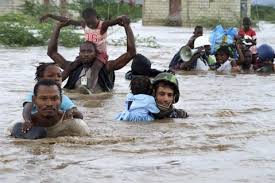
Floods are one of the most common and devastating natural disasters, affecting millions of people worldwide each year. They occur when water overflows from its natural boundaries and inundates normally dry areas, causing widespread damage to homes, infrastructure, and ecosystems. This article delves into the causes, types, impacts, and prevention measures related to floods.
Causes of Floods
Floods can result from a variety of natural and human-induced factors.
Some of the primary causes include:Heavy Rainfall: Prolonged or intense rainstorms can overwhelm drainage systems and rivers, causing water to spill over.
Snowmelt: Rapid melting of snow during warmer months can cause rivers and streams to overflow, especially in regions with heavy snowfall.
Storm Surges: Coastal areas are particularly vulnerable to storm surges, where strong winds and low pressure during hurricanes or tropical storms push seawater inland.
Dam Failure: Human-made structures like dams and levees can fail, releasing large volumes of water downstream.
Urbanization: Rapid urban development can reduce natural drainage, as impermeable surfaces like concrete and asphalt prevent water from soaking into the ground, increasing the risk of flash floods.
Types of Floods
There are several types of floods, each with unique characteristics and impacts:River Floods: These occur when rivers or streams overflow their banks due to excessive rainfall or snowmelt.
Flash Floods: Sudden and intense floods caused by heavy rainfall or dam breaches. Flash floods develop quickly, often with little warning, and are especially dangerous.
Coastal Floods: These floods are triggered by high tides, storm surges, or tsunamis and affect coastal regions.
Urban Floods: Occur in densely populated areas with insufficient drainage systems, often resulting from poor planning or overdevelopment.
Groundwater Floods: These are caused when the water table rises above the surface due to prolonged rainfall or poor drainage, leading to waterlogged conditions.
Impact of Floods on Communities and the Environment
Floods have both immediate and long-term effects, impacting people, property, and ecosystems.Human Impact: Floods displace people from their homes, cause fatalities, and lead to the loss of livelihoods. In many cases, the destruction of infrastructure such as roads, bridges, and communication lines hampers rescue and recovery efforts.
Economic Damage: Floods cause billions of dollars in property damage, affecting homes, businesses, and agricultural lands. Repairing flood-damaged infrastructure and compensating affected populations is costly and time-consuming.
Health Concerns: Floodwaters often carry contaminants, leading to the spread of diseases such as cholera, dysentery, and malaria. Stagnant water can become breeding grounds for mosquitoes, exacerbating the spread of diseases.Environmental Effects: Floods can significantly alter landscapes, eroding soil, uprooting trees, and destroying habitats. However, they can also bring benefits, such as depositing nutrient-rich sediments that improve soil fertility.
Flood Management and Prevention Strategies
While floods cannot be entirely prevented, several strategies can help mitigate their impacts:Early Warning Systems: Governments and meteorological agencies use sophisticated monitoring tools and satellite imagery to predict floods and provide timely warnings to at-risk populations.
Floodplain Zoning: Regulating construction in flood-prone areas reduces the risk of property damage. Floodplains can be reserved for agriculture, parks, or natural spaces to absorb excess water.
Building Levees and Dams: These structures are designed to control the flow of water, although their failure can lead to catastrophic flooding.
Regular maintenance is crucial for their effectiveness.
Improved Drainage Systems: Urban areas can improve flood resilience by investing in drainage infrastructure, green spaces, and permeable surfaces to help water soak into the ground.Reforestation and Wetland Restoration: Natural ecosystems such as wetlands and forests act as buffers, absorbing excess rainwater and reducing the likelihood of floods.Community Preparedness: Educating communities about flood risks and preparedness measures, such as having evacuation plans and emergency kits, is essential in minimizing the impact of floods.
Climate Change and the Future of Flood Risk
Climate change is expected to increase the frequency and intensity of floods worldwide. Rising global temperatures contribute to more extreme weather patterns, such as heavier rainfall, more intense storms, and faster snowmelt. Sea level rise also increases the risk of coastal flooding, putting millions of people living in low-lying areas at greater risk.As a result, flood management strategies must evolve to account for the growing threat posed by climate change. This includes updating infrastructure, incorporating nature-based solutions, and improving global cooperation to address cross-border flood risks.
Floods are a significant global challenge, with far-reaching consequences for human communities, economies, and ecosystems. Understanding the causes and types of floods, as well as the importance of effective flood management strategies, is key to reducing their impact. As climate change continues to exacerbate flood risks, it is essential that governments, organizations, and individuals work together to build more resilient communities and safeguard the environment.
Subscribe to Follow Global Trends for daily global news.
Find Out How To Make Money As A Full Time Writer/Blogger Guide.
To Advertise, Advertise Your Affiliate Links on FollowGlobalTrends.com for Just $1 Per Link Per Month!
Related Articles
Flash Floods Leave Dozens Missing in Yemen, Further Raise Cholera Risk
Deadly Floods Leave Millions Stranded in Bangladesh: A Catastrophe Unfolds
Devastating Flash Floods Strike Afghanistan
Brazil floods raise specter of climate migration
Tragedy Strikes Amidst Texas Floods
Written by: Enyoghasi Ngozi pricillia

